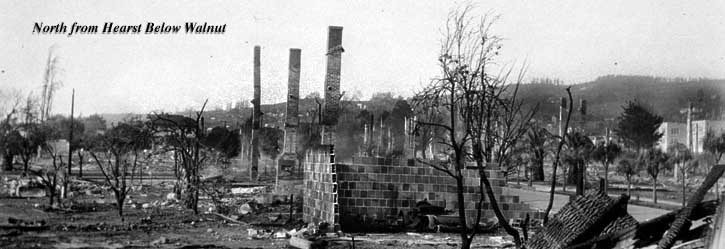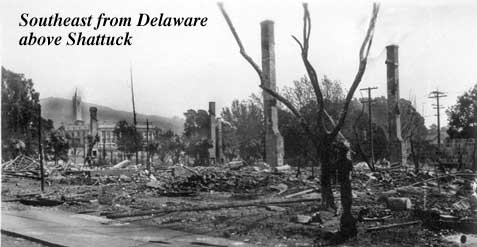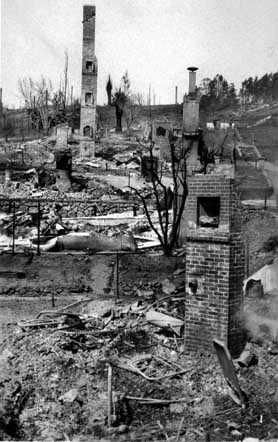 to the Berkeley Conflagration of September 17, 1923 This is an extract from the Report on the Berkeley, California Conflagration of September 17, 1923, issued by the National Board of Fire Underwriters’ Committee on Fire Prevention and Engineering Standards. _____________________
The Berkeley fire began in Wildcat Canyon around noon, and by 2:20 p.m. — spread by fierce “Santa Ana” winds — had rolled into the city limits. At 2:30 p.m., aid was requested from Oakland, Alameda, Emeryville, Piedmont, Richmond and Hayward. The Oakland Fire Department had 13 fires burning at the time of the call and was not immediately able to provide assistance. At 3:30 p.m., The Oakland Fire Department had not responded to the aid request, and Berkeley Chief of Department G. Sydney Rose then “...ordered the fire alarm operator to call assistance from San Francisco: due to congestion of the lines this call had to be put through at the Berkeley exchange under the personal supervision of Manager Glover of the Pacific Telephone and Telegraph Company,” said the Underwriters’ report.
“San Francisco responded to the call for aid with four engines, two
hose wagons, two chemicals and one fire boat. Engines are
750-gallon
pumpers, each having hose body and chemical tank: hose wagons each
“Engine Companies 5 and 9, and Chemical Company 3 left the city on the 4:20 Southern Pacific Ferry, landed at the Oakland mole and reported to Chief Rose shortly after 5:00 p.m. “Engine Company 9 was assigned to the hydrant at Vine and Oxford streets where, with the assistance of the hose company from Richmond, two 1,000-foot lines were worked along Vine and Spruce streets to Cedar street and along Vine to Arch street, checking the fire at both locations. “Engine Company 5 was sent to Euclid avenue and Ridge road, but finding no water at that location helped control a fire at the municipal dumps at the foot of Cedar street, following which the company was sent to the Durant avenue fire station, working later in the evening along the east side of the burning district. “Chemical Company 3 was sent to the Durant avenue fire station, working later on the dump fire and the east side of the burned area. “The remaining San Francisco companies left 20 minutes later. Engine 12 worked two 1,000-foot lines from Shattuck and University avenues until 10:00 p.m. Engine Company 2 was sent to the Durant avenue fire station, worked at municipal dump fire and later worked at the south-eastern corner of the burned area. Chemical Company 4, after extinguishing several roof fires, was stationed at the Regent street fire station.” In 1992, Captain Frank Treanor of the San Francisco fire boat Phoenix, said the Company Journal for September 17, 1923, as entered by Relief Pilot Flanison, indicated that the fire boat departed San Francisco at 4:15 p.m. and tied up at the West Berkeley Pier at 4:45 p.m. A further notation from the relief pilot indicated that the fire boat was “ordered to go home” at 9:15 p.m. which gave the fire boat company almost five hours of land firefighting duty in Berkeley. Return to the Table of Contents of the San Francisco Fire Dept. Report on the 1991 Oakland-Berkeley Hills Conflagration. |

 carried 2,000 feet of hose: chemicals having double 100-gallon tanks.
Engine companies consist of 6 men each; chemical companies, 2 men each;
fire boat crew, 7 men. The fire boat left the San Francisco water front at
4:15 p.m., proceeded to the Berkeley wharf and reported to Chief Rose at
about 5:00 p.m. Later, after collecting a wagon load of hose, the crew of
the fire boat worked a line from Engine 5 of the Oakland department west
along Ridge road to Euclid avenue.
carried 2,000 feet of hose: chemicals having double 100-gallon tanks.
Engine companies consist of 6 men each; chemical companies, 2 men each;
fire boat crew, 7 men. The fire boat left the San Francisco water front at
4:15 p.m., proceeded to the Berkeley wharf and reported to Chief Rose at
about 5:00 p.m. Later, after collecting a wagon load of hose, the crew of
the fire boat worked a line from Engine 5 of the Oakland department west
along Ridge road to Euclid avenue.